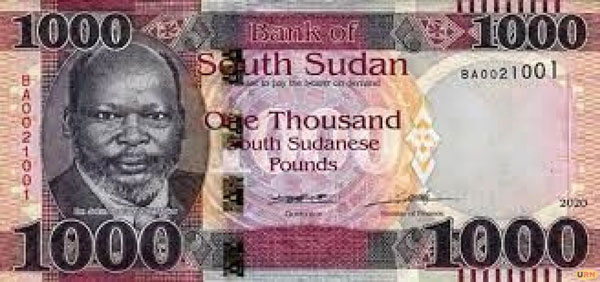
Juba, South Sudan | THE INDEPENDENT | When the hackers seized the website of the central bank of South Sudan late last week, it was the reason that the hijackers gave that raised more concern about the country’s economy than the attack itself.
The hackers, calling themselves “Anonymous South Sudan” said they wouldn’t return the website until the government slashed the dollar exchange rate to 400 South Sudan Pounds, a cut of more than half.
By April 6th, just before the seizure, the official exchange rate was 841.5 SS pounds to the US dollar buying and 866.2 selling. By Tuesday, however, the rate had escalated further to 844.5 buying and 870 selling.
On the black market, the dollar sells at an average 950 pounds. The Pound has been sharply losing its strength since 2020, but the situation worsened especially due to the global high commodity prices in 2021.
At the time of release of the South Sudanese pound in 2011, the exchange rate was 2.75 SS Pound for 1 US dollar.
After the recent Monetary Policy Committee meeting, the Governor Bank of South Sudan (BoSS) Johnny Ohisa Damian said the currency decline was not only limited to the SS Pound but that many countries were suffering the strength of the US Dollar.
He also cited the increase in prices of imports from Uganda, its main source of food supply, for the high inflation in S Sudan.
“In addition, the increase in prices of imported goods elsewhere and major trading partners like Uganda whose prices rose by more than 50% in January, have a strong bearing on food prices in the markets in Juba,” he said.
Like with the US Dollar, the SS Currency has been losing value against other currencies including in the region.
On Tuesday morning, the Uganda shilling was exchanging at 0.2308 shillings to the pound, compared to 0.229 recorded on April 6. The Kenya shilling opened trading on Tuesday at 6.564 per pound compared to 6.5370 last Thursday.
The Monetary Policy Committee in March raised the interest rate from 13 to 15 percent to try to halt the depreciation, but this has not born fruit.
In February, the government in Juba issued a ban on the use of US dollars for all domestic transactions, a move supported by the International Monetary Fund, IMF, with the hope of propping the pound.
Most of the transaction were being conducted in dollars with the trend increasing, while, according to a report in March, 77 percent of the deposits at commercial banks were in dollars.
According to the Bank, other factors that contributed to South Sudan’s economic hardship are the U.S.
Federal Reserve tightening its monetary policies and banking crisis. Damian insists that South Sudan is not alone in the economic upheaval, which it said is a global phenomenon.
“The US dollars strengthened sharply against major currencies including but not limited to South African Rand, Egyptian Pounds, Kenyan Shillings or South Sudanese Pounds,” he said.
In February, BoSS announced the sale of 5 million US dollars in two tranches to eligible forex bureaus through an auction, but this hardly had any impact on the exchange rate.
Governor Damian now says they have resolved to sell 5 million dollars weekly into the market, adding that the amount will increase if the situation makes it necessary.
“The Bank will continue to monitor and review the situation and respond with appropriate measures, as the situation warrants,” he says.
While all countries have suffered from the strengthening of the dollar and the high global commodity prices over the last two years, the world’s newest country’s bigger challenge is the undiversified economy, mainly exports.
Oil exports account for 82 percent of the country’s export value with about 630 million dollars. The other exports being fresh crops and sheep and goat meet.
A plunge in global oil prices affect the country’s overall revenues because of overreliance on one export.
However, according to analysts, because of the country’s financial obligations with many multinationals, the value received from the oil exports (150,000-170,000 barrels per day) is equivalent to just 50,000 barrels per day.
Despite the exchange rate volatility, the headline inflation continues to show signs of easing, dropping to 13.4 percent in February, from 14.4 percent registered in January 2023.
In comparison, the Uganda shilling has fluctuated between 3,690 and 3,790 to a dollar and is currently exchanging at 3,732 according to the Bank of Uganda’s Tuesday mid-day trading update.
******
URN
 The Independent Uganda: You get the Truth we Pay the Price
The Independent Uganda: You get the Truth we Pay the Price



